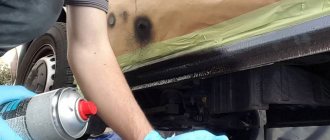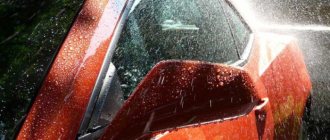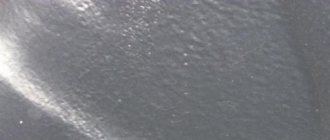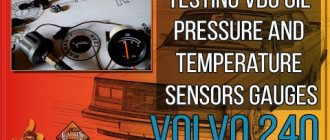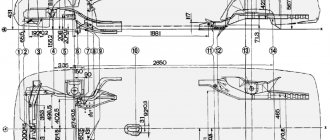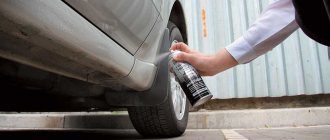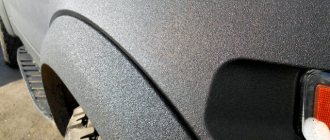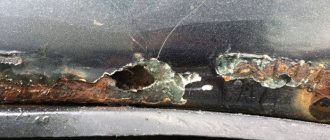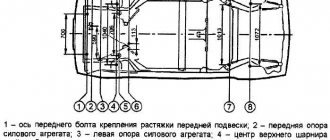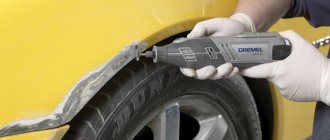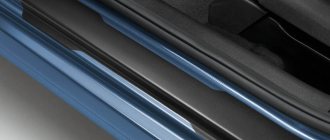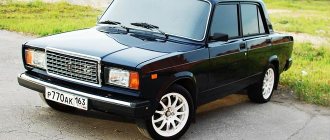Corrosion on the body is a nightmare for many motorists who care about their “iron horses”. Thin metal is susceptible to many destructive factors. Foci of corrosion quickly spread and increase in size in a beneficial environment. Movil for cars will help save the body from rust and prevent the appearance of new problem areas.
Movil: types, which is better and do-it-yourself car treatment
The formation of corrosion on a car body can lead not only to the loss of the appearance of the car, but with prolonged exposure to the complete destruction of thin metal over the entire area.
If the engine or transmission after a major overhaul, in terms of its main characteristics, practically does not differ from the new state, then eliminating numerous areas of metal rusting can be very difficult, and sometimes even economically impractical. It is much easier to prevent the destruction of a metal body than to then try to patch through holes using welding or putty. One of the most effective means for preventing the formation of corrosion on a car body is Movil.
Anticorrosive is deservedly popular among car enthusiasts. How to apply Movil to a metal surface, as well as which Movil is best for a car, will be described in detail in the article.
How to prepare a car for processing?
First you need to prepare the surface and then apply Movil directly. What it is? This is a simple preparation that will make the drug even more effective.
First of all, the car must be thoroughly washed. If you plan to treat the bottom, then it is washed while the car is on the lift. It is best to use a pressure washer with hot water. After the procedure, the body must be thoroughly dried.
Next, various defects that exist on the metal surface are eliminated. Loose rust should be removed. Then an anti-corrosion agent is applied. When the product dries, a protective film with a layer of 40 to 60 microns will begin to form.
What is "Movil"?
Many motorists call any anti-corrosion agent for a car Movil, but this is incorrect. The original Movil contains the following components:
- Engine oil.
- Drying oil.
- Anti-corrosion substances.
If an anti-corrosion drug has a different composition, then it cannot be called Movil. A product for protecting the body from rust, under the original name “Movil,” was simultaneously developed by research institutes located in Moscow and Vilnius, for which it received its name from the first letters of these cities.
Anticorrosive agent was invented in the last century, but despite the huge range of various anti-corrosion agents available on the Russian market, this anti-corrosion agent is still in high demand among car owners today, due to its low cost and high quality.
To know which Movil to choose for your car and how to use this anti-corrosion agent, you need to determine what type of rust preventative to purchase for treating the body.
Types of anticorrosive
Types of Movil for cars are presented in 3 categories:
1. Aerosols are the most popular and convenient means for applying anti-corrosion composition.
The price of a 520 ml can ranges from 200 to 300 rubles. Treating the car body with such packaging will cost the motorist much more, due to the gas inside the canister, which is used for spraying.
The inconvenience of using this type of anticorrosion agent may also lie in the need to keep the canister in a vertical position, so for anti-corrosion treatment it is better to purchase a canister equipped with a special tube with a spray at the end.
2. Liquid Movil is an inexpensive option for use as an anti-corrosion treatment. The cost of a 3-liter canister is only 300 - 400 rubles.
The consistency of the liquid composition allows for effective treatment of hidden cavities. The product is easily applied to thresholds and internal door cavities. You can get the most even distribution of the substance inside hidden cavities using an original spherical nozzle, which allows you to process every square centimeter of the internal area of the metal elements of the body.
3. Paste-like Movil, most often sold in tin or plastic packaging, in the form of cans.
The cost of such a drug for treating a car is about 200 rubles. per package weighing 0.86 kg. The product is applied to the surface to be treated with a brush, and to treat internal cavities it is diluted with a solvent.
After a vehicle body treatment product has been selected, it is necessary to thoroughly prepare the body surface on which the anti-corrosion compound will be applied.
Preparing the car
The underbody of the car is most often subjected to anti-corrosion treatment. This part of the body is most susceptible to destructive processes, especially when the car has to be operated in high humidity.
Mechanical damage from stones and sand from under the wheels also causes significant damage to the lower part of the car body. The following body elements are subjected to anti-corrosion treatment using Movil:
- Spars.
- Floor thresholds.
- Door pockets.
- Front and rear arches.
- Central pillars.
- Headlight covers.
All listed places must be properly prepared. First of all, it is necessary to thoroughly clean the surface to be treated from dirt and dust. For this purpose, you can use a portable car wash with the addition of special detergents that will clean the surface not only of dirt, but also of oily deposits.
After thorough cleaning. The surface on which Movil will be applied must be free from moisture. If the treatment is carried out in the summer, then it is enough to dry the car in the open air for several hours. In cold or damp seasons, you need to use a compressor to remove moisture. Blowing with compressed air will reliably remove moisture from the surface, after which it will be possible to apply the working solution to the metal surface without any obstacles.
After cleaning the surface of the underbody of the car from contamination, you should inspect the paintwork of the lower part of the body. If areas of paint peeling or swelling of the paint are identified, then such areas must be cleaned with a wire brush or coarse sandpaper. If pockets of rust are found on the underside of the car, such places must also be properly treated before applying Movil.
You can also use sandpaper or a grinder to remove corrosion.
When the metal surface is cleaned, it should be treated with any rust converter in order to stop the destructive process in the metal.
After completing all preparatory procedures, you can begin directly applying the anti-corrosion composition to the underbody of the car.
How to apply Movil
Do-it-yourself car treatment with Movil can be done in a garage, without the need to use expensive equipment. What body treatment tool you will need to apply the anti-corrosion agent depends on its consistency.
Liquid Movil is much more practical to apply using a sprayer. If it is not possible to use a liquid product or you don’t know how to dilute the Movil to the desired consistency, you should use a small brush.
If you need to dilute Movil, then this is not difficult to do. For this purpose, you can successfully use “White spirit” or “646” solvent.
The anticorrosive agent is applied to the previously prepared surface in an even layer. The vehicle can only be operated a few days after the anti-corrosion treatment has been completed.
Precautionary measures
- Movil contains substances, inhaling vapors of which can cause poisoning, so it is recommended to carry out work outdoors or in a well-ventilated area.
- In order to be able to safely use the car after application, you also need to know how long Movil takes to dry. The anti-corrosion agent takes a very long time to dry, so an unpleasant odor will be felt in the car interior for at least 3 days. To avoid poisoning from solvents and other volatile substances, after applying the substance, you should stop driving the car for several days.
- In addition to vapor poisoning, during treatment you can get burned from contact of the working composition with exposed skin or eyes, so it is recommended to carry out anti-corrosion work in closed clothing and gloves. And when using aerosol cans or a spray, wear safety glasses.
Reviews of aerosol Movil
Although Movil in aerosol form is less popular than car preservative in cans, it is often used by car owners. Users leave various reviews about this tool, there are both negative and positive comments.
Dmitriy. I would like to express my opinion about the Movil preservative in an aerosol can; I bought the Eltrans product in order to treat the front subframe, which has many hidden cavities. The bottle comes with a nozzle with a straw, so spraying the liquid is very convenient. Movil spreads well over the surface, creates a layer similar to solid oil, but emits a rather pungent odor. I liked that this composition is good for treating hard-to-reach places, I can’t say anything about the effect yet, I don’t seem to have noticed any rust. In general, I liked the bottle, the advantages are ease of use, fairly economical consumption (a liter bottle was enough for the entire subframe), I didn’t find any disadvantages.
Yuri. I bought Movil with a rust converter (manufactured by Astrokhim), and was fooled by the advertising. I don’t know who this chemistry helps, for me personally it’s complete nonsense. The product does not combat corrosion at all; the spray nozzle becomes clogged almost immediately and cannot be cleaned. I threw the can in the trash, I won’t buy anything like it again.
Alexei. After 2 years of using my car, I decided to treat the engine compartment, underbody and fenders with a preservative before winter; for this I bought Movil BBF. I did the processing myself, did everything according to the instructions, it took me three bottles, and the total cost was less than 400 rubles. I have been using car preservative for two years now, there are no salt deposits or traces of rust on the car. I recommend this product because it is inexpensive, easy to apply, and gives the desired effect.
Leonid. I have been working with Movil for a long time, since 1998, only then it was sold in a bottle, and I applied it with a brush. Recently I have been using BBF, although the packaging says that it is an anticorrosive agent for hidden cavities, I treat it on my car 2108 and external surfaces, and carry out preventive maintenance before winter. The opinion about the autopreservative is positive; it works effectively, especially since it costs much less than its foreign analogues.
When using Movil, it should be taken into account that the product does not adhere well to mastic, corrodes rubber parts, and is a fairly toxic substance. And you should not apply an anti-corrosion compound to a rusty metal surface; the metal under the anti-corrosion layer will continue to rot. In general, this product quite effectively protects the car body from premature corrosion and does not allow new rust to appear under the protective coating layer.
Movil with a rust converter - aerosol and liquid, is used to preserve hidden cavities in the car body. Its purpose is to transform existing rust and prevent the formation of new ones. This is just one of the anticorrosion agents, but it is one of the first to be produced in Russia, therefore it is best known to car enthusiasts.
Initially, the formula of this product was developed by the Moscow and Vilnius Research Institutes, which was reflected in the name. Today, this formula has been improved and various ingredients have been introduced into the composition that improve anti-corrosion properties, including rust converters. Anticorrosion agents in Movil, the name of which is indicated “with a rust converter,” are produced by several Russian companies.
How to choose Movil for a car
An article about Movil: varieties, selection rules, working with Movil - tips and important recommendations. At the end of the article there is a video on how to “mobilize” a car.
The underbody of the car is most susceptible to corrosion; moisture and road dirt accumulate on it. We don’t see what condition it’s in because it’s inaccessible. Therefore, a rusty bottom is one of the most common problems on the body. In order to put an end to rust formation once and for all, it is necessary to treat problem areas with anti-corrosion agents, among which Movil stands out.
Video
For those who don't like to read, after watching this video you will know what MOVILLE is?
And this video received several thousand likes for useful advice. How to remove saffron milk caps in 5 minutes.
Improved new mobile in a can.
The bodies of modern cars are able to withstand through corrosion for an average of 5 to 10 years, then gradually the rust begins to “eat up” the body parts, and over time, pockets of rust appear on the bottom and wheel arches. To ensure that the body iron lasts as long as possible, special protective agents are used, in particular, Movil is used to treat the lower part and hidden cavities of the body.
The anti-corrosion coating protects the metal from premature rusting, which occurs as a result of the negative influence of the environment; the metal corrodes due to interaction with water (moisture) and oxygen. Various bitumen mastics and special chemical compositions applied to body iron allow you to extend the life of the metal and delay the next repair.
Anti-corrosion materials
There are several different types of anticorrosion agents that are popular among car enthusiasts. Anti-gravity agents are most commonly used
, which are small cans filled with an expensive substance containing rubber to hold the bottom elements together. Apply by spraying.
Next, you can consider paste-like materials or mastics
, which are applied in a thin layer to body elements subject to corrosion.
What remains is Movil, which consists of numerous additives, motor oil and drying oil
. This composition is patented, so other mixtures and proportions can no longer be called Movils - they are distinguished by their low cost and ease of application. However, over time, the treated layers are washed away, which leads to the need to treat the body again.
Classification of Movils by physical condition
This classification involves division into several types:
- spray;
- liquid;
- paste.
The spray or aerosol is supplied in 500 milliliter cans. One can will cost 4-5 dollars and will be very useful for covering the sills and arches of a problematic body. Basically, the cylinder is equipped with an additional tube, which will help when covering hard-to-reach surfaces. If you don’t have a straw, you’ll have to get a gun or spray bottle, but the gun can only spray liquid substances.
The liquid is supplied in cans. A container with Movil with a volume of 3 liters will cost 6-7 dollars. Using liquid Movil is much easier than using a spray. You will need to get a brush or even a sponge with which you can apply the anti-corrosion material.
When used, liquid Movil is poured into a pistol or another container, but with a wider neck. The remaining preservative is poured into the canister. The liquid product has sufficient viscosity, so it is also useful when treating hard-to-reach surfaces, as well as the bottom. The liquid preservative has no significant disadvantages.
Movil paste is distributed in metal or plastic jars. The average cost of an 800 gram jar is about $4. The area of use for the paste is the same as for the liquid. The paste has a higher viscosity, so it must be diluted with solvent 646 - this is done right before processing.
The paste can be used to treat any body surface (arches, sills, pillars), since it also does not have any significant drawbacks.
Classification of Movils by chemical composition
In addition to the classic Movil formula, some manufacturers try to add something of their own in the form of one additive or another. This somewhat changes the properties of the anticorrosive, but also significantly affects the cost of the coating. The following compositions are distinguished:
- regular Movil without additives;
- composition with added zinc;
- composition with the addition of corrosion converters.
We will not consider the usual Movil, but will pay more attention to its modifications.
Zinc Movil is distinguished by the fact that before its use there is no need to remove corrosion - the damaged areas are immediately treated with Movil containing zinc, which will remain after the coating is applied. The zinc coating will significantly increase the service life of body elements, since it will create auxiliary protection while the car is moving.
The corrosion converter contained in Movil independently eats away rust, so you won’t need sandpaper or a grinder before processing.
Advantages of modified Movils:
- it will take less time to process surfaces;
- less financial costs;
- less labor-intensive to work with.
The only drawback of the modifications is their higher cost.
Short materiel
Since you need to think not only about covering the paint layer with wax , but also about protecting the body from rust, we list the main areas that usually need anti-corrosion treatment:
The industry produces a fairly wide range of anticorrosive products. All of them are divided into two groups - materials based on synthetic resins or bitumen and wax-based. Each manufacturer offers its own chips in the form of additives in the form of zinc, polymers, rubber or bronze.
To correctly understand what an anti-corrosion agent does for a car and which is better in all this abundance, it is enough to know two things:
- Hardening mastics are used to treat open elements of the body structure: the bottom and wheel arches.
- Non-drying preparations for hidden cavities with insufficient ventilation: thresholds and counters.
The quality of anti-corrosion protection depends on the level of surface preparation and compliance with technological nuances. It's a bit like painting a car in the garage - don't expect any quality without a thorough initial step.
Some motorists prefer to make their own mixtures, but this often ends in wasted time and money. Therefore, it is worth using factory preservatives, especially since there is no shortage as such, and their price is quite affordable.
The principle of applying Movil
When applying the coating, you will be convinced of another advantage of Movil - it is very easy to process body elements with it. Most of the work can be done independently without the use of additional help.
If you use regular Movil, before starting processing you will need to get rid of dirt and then corrosion. Classic abrasive tools such as a sandpaper, grinder or grinder can help with this. A corrosion solvent applied with a brush or sponge is also useful.
Once the corrosion has been removed, the treated areas should be washed and left for a while to allow the moisture to dry.
. And when the surface is dry and free of corrosion, you can begin treating it with Movil.
It is recommended to treat the body with several layers of anticorrosive to achieve the greatest effect.
These simple actions on the car body are carried out every year before the first snow falls. Even if you don’t see places covered with rust, anticorrosive treatment won’t hurt at all. Constant treatment with Movil will help rid the car of corrosion and increase the service life of its most capricious elements without significant financial costs.
Video on how to “movilize” a car:
Let's find out which anti-corrosion agent for a car body is better when treating internal cavities
The main feature of this type of anticorrosives is their oil base, which does not dry out. Such a preparation will always be in a liquid state, which gives it the opportunity to fill all microcracks. Most formulations are made on a paraffin or wax base.
It is important to note that repeated treatment with mixtures of the same composition will not give the desired result. For example, you cannot work with wax on wax or mastic on mastic, because the new solution will not get inside the existing coating, and corrosion will progress.
To understand the best way to treat the underbody of your car against corrosion, you need to remember several important requirements that apply to anti-corrosion mixtures for hidden surfaces:
- Homogeneous composition structure and high degree of adhesion.
- The anticorrosive agent should not destroy the paint on the car body.
- Prevent contact of moisture and electrolytes with the metal of the body.
- Formation of an elastic film and thorough filling of all microcracks.
Movil-Zinc from Tantalum
The product is available in plastic containers and is a liquid composition that can be applied even with an ordinary sprayer. The treatment procedure is not particularly difficult, just like removing scratches with a car pencil , so it can be done by a novice driver.
The coating can easily withstand pressure washing, but is not able to withstand crushed stone and gravel. The mastic is absolutely neutral to rubber, so it is suitable for processing metal elements under glass and door seals. It is this quality that distinguishes this product from Movil in a glass bottle, the latter deprives the rubber of its elasticity.
Main areas of application: internal cavities of the wings and trunk, body structures under seals and the floor inside the car. Experienced motorists actively use Movil-Zinc to protect painted and chrome-plated car parts. Even after three to four years, after removing the coating, chrome retains its shine.
Zinc BodySafe by Tectyl
The drug combines all the wonderful properties that exist in Movil and mastic. Available in aerosol cans complete with all kinds of attachments for comfortable work. The mixture has good fluidity, so there is no need to generously treat the surface, otherwise you could waste the anticorrosive agent.
If you have not yet decided which anti-corrosion agent is best for protecting your car from rust, then this is the drug that you should pay attention to:
- The aerosol jet makes it possible to reach any bends and cavities.
- The coating perfectly resists peeling even when under-film corrosion develops.
- The coating has a fairly hard structure, which allows you to do without additional treatment for a year or two, and if the car is equipped with mudguards, then it will last for 5-6 years.
- Possibility of processing the underbody of a car.
The manufacturer assures that the drug fits well even on areas susceptible to corrosion. But practice shows that it is better to first get rid of the rye, phosphate and paint the car , and only after that apply a protective mixture. In turn, Tectyl experts recommend making a three-layer coating, which includes:
- The first layer is Tectyl Zinс ML.
- The second layer is Tectyl BodySafe.
- The third layer is Tectyl 190.
Of course, such a processing scheme will not be cheap, but reviews from car enthusiasts claim that the technology is worth the money. For drivers who prefer to do without mudguards, the experts recommend treating the bottom of the sills with a layer of Body 930, and covering the top with Tectyl.
Movil for cars - what is it and how to use it
packaging Increasing the corrosion resistance of a car body is an important issue of concern to any motorist.
The modern level of painting, priming or cataphoresis treatment of metal allows manufacturers to confidently declare a guarantee of 5 or even 10 years against through corrosion. However, the use of increasingly aggressive reagents in winter, as well as constant mechanical impact on the paintwork, especially in the area of the arches and bottom, forces one to resort to additional treatment of the body. The market for anti-corrosion materials is very wide, but material such as Movil enjoys well-deserved recognition, which, together with its low price, puts it in first place in popularity in our country.
Movil for cars - how to use
The best option for using Movil is to apply it to arches, welds and hidden cavities of a new car, since application to a surface that is already susceptible to corrosion will not solve the problem, but will only slow down its development.
It is highly not recommended to treat cars with Movil in the interior, since this material has a strong specific odor and can cause poisoning, similar to poisoning with paint fumes.
The main requirement that must be met regardless of the type of surface, its location and method of application is the absence of moisture, since if this is not met, you can personally ensure the formation of a corrosion center by preserving the water under a layer of protective material.
Movil must be applied to a cleaned surface by spraying or coating, and it is very important to choose the right consistency by adding a solvent. A mixture that is too thick will not penetrate the weld, will not lie tightly and evenly on the surface, and an overly plastic or even flowing mixture will simply drain from the surface.
Do not forget that the consistency of Movil for cars depends very much on temperature, so it is better to carry out work in a warm room, this will eliminate the need for excessive plasticization. In extreme heat and under the influence of direct sunlight, the material liquefies, flows off the surface and greatly increases the odor, this is another reason why it is not recommended to add too much solvent.
The situation is much simpler with Movil in the form of an aerosol can, since the consistency has already been selected and no additional devices are required for application. In this case, the treatment must be repeated in several stages as the applied layers harden, since when sprayed, the thickness of the anti-corrosion material is extremely small.
In addition, aerosol spraying uses efficient but quick-drying sprays, so the durability of the protective layer is usually less.
Hidden cavities are best treated by extrusion, that is, pumping anti-corrosion material under pressure through a metal tube, since spraying and coating will not allow for its uniform distribution.
It must be remembered that after application the car should not be driven for at least 24 hours. During this time, the Movil should thicken, which will ensure good adhesion to the surface. No additional drying is required. The preparation should not dry out completely, since this is the main guarantee of its effective operation; over time, Movil thickens and becomes elastic, but not completely dry.
Surfaces that are recommended to be treated:
- hood and trunk lid stiffeners;
- spars;
- cavities of the front and rear arches;
- door pockets;
- headlight housings;
- B-pillars;
- floor thresholds.
It is not advisable to treat open surfaces exposed to atmospheric or mechanical influences, such as the bottom of a car, since anti-gravel coating is used for such places.
There is a misconception that Movil for cars can promote galvanizing of parts, which is why some motorists add up to 25% zinc oxide to its composition, which does not in any way affect the anti-corrosion resistance of the metal, since the effect of Movil is based on conservation, and the inhibitors it contains neutralize corrosion, no electrolytic dissociation occurs.
You should not rely on the assurances of marketers that Movil with a rust converter does not require pre-treatment of the surface. The concentration of the converter or inhibitor in it is not enough to eliminate foci of corrosion, and it is intended to increase the effectiveness of protection, and not to eliminate rust.
Anticorrosive rating for a car
The following is a rating of popular and effective anticorrosion agents for car bodies. The list includes products for which real positive feedback or reviews have been found. The rating is not commercial, but purely for informational purposes; advertising is excluded. The review is divided into two parts - products for open surfaces (underbody, sills, wheel arches), as well as products for internal surfaces.
If you have your own experience using the tools listed below, or any others, share it in the comments. This will be useful to everyone.
Anticorrosion agents for open surfaces
Dinitrol 479
Anti-corrosion agent Dinitrol 479 is made on the basis of synthetic rubber with the addition of corrosion inhibitors. Many car dealerships, when selling a car, immediately offer buyers to treat their new car with this product. This is due to the fact that the Dinitrol anticorrosive agent must be applied to the surface using a special technology, and in a garage it is quite difficult to do this with your own hands.
Anticorrosive agent Dinitrol 479 has excellent adhesion, adheres perfectly to the surface, and is applied using a spray gun. The product has good mechanical protection of the body, excellent sound insulation, and reliably protects against moisture, salts, and chemicals. A special feature of anticorrosive is its high density. For this reason, it cannot penetrate micropores, and accordingly, it is recommended to be used as a prophylactic agent, for example, for new cars.
It is sold in 5 liter jars. The price of one such can as of spring 2022 is about 3,500 Russian rubles.
1
- Advantages:
- excellent performance properties - mechanical, chemical, noise insulating;
- durability of use;
- optimal ratio of price, quality and packaging volume.
- Flaws:
- the need to comply with special application technology;
- Recommended for use only with relatively new cars (or after body repairs).
Tectyl Bodysafe
Tectyl Bodysafe anti-corrosion agent is based on bitumen. Designed for use on open surfaces. It is a very effective means of protecting salts and other chemicals. It tolerates sudden and significant temperature changes and has good inhibitory properties. On the Internet you can find a lot of negative reviews about this anticorrosive agent, but often the reason is that car enthusiasts do not follow the technology of applying the product to the surface, and this is very important in this case!
Among the shortcomings, one can note the average mechanical protection. That is, small pebbles at high speed can damage the anticorrosive layer. To prevent this from happening, it is recommended to apply the product in several layers. Also, anticorrosive "Tektil" has a low noise-reducing effect.
Tectyl Bodysafe anticorrosive agent is sold in various packages. The most common one on sale is a 5 liter jar. To work with the product you need a spray bottle; applying it with a brush is not recommended. The approximate price of this packaging in 2022 is about 4,000 Russian rubles.
2
- Advantages:
- long period of protection;
- resistance to chemical reagents;
- resistance to temperature changes, as well as to critical temperatures;
- high adhesion;
- ability to penetrate micropores in paint and metal.
- Flaws:
- low mechanical protection (strength);
- low sound insulation of the car interior;
- relatively high price.
Body 950
Anti-corrosion composition Body 950 is intended for treating the underbody, wheel arches and sills of the car body. It is a gray spray. Made from rubber and resin. It can be applied directly to the factory coating of the car (note that it is advisable not to apply it to the paintwork, since it has its own color, or after that, paint the treated area separately). Anticorrosive body 950 reliably protects the car body from gravel, chemicals, and moisture. When applied to rust, it localizes it and prevents it from spreading further. Can be used with any paint system.
Car enthusiasts note the average effectiveness of using Body 950 anticorrosive. It really does a good job of protecting the body from harmful factors, but it has a short service life, so it needs to be updated regularly every 1-2 years. Anticorrosive coating is applied in two or three layers. Drying time for one layer is about 20...30 minutes. Complete drying occurs within a day. One can is enough to treat half a square meter, painted in two layers.
Anticorrosive 950 is sold as a spray in a 400 ml can. Its price for the above period is about 300 rubles.
3
- Advantages:
- Ease of use;
- high drying speed;
- good level of mechanical protection, as well as protection from chemicals and noise;
- low cost.
- Flaws:
- works well only with relatively new cars; the product is not so effective for protecting rusted bodies;
- has a pungent odor.
Anticorrosive Hi-Gear with rubber filling
The composition of the anticorrosive "High-Gear" is made on the basis of synthetic rubber. It also contains corrosion inhibitors and protective elements. Anticorrosive is intended for treating the underbody and wheel arches of a car. Can be used both on new surfaces and simply on rust. However, real experiments have shown that anticorrosive agent quickly rebounds from rusty surfaces, so it is recommended to use it specifically as a prophylactic agent for application to the body of an old but well-maintained car.
It is applied quite simply from an aerosol can. It is only noted that when you press the balloon button, the portions that fly out are very large, so it takes some time to adapt to this. The instructions directly indicate that the product should be applied in two layers the first time, and one at a time in subsequent ones. Drying time for the first layer is 20 minutes. The time for complete drying of the product is 3...12 hours. The bottle comes with an extension tube for using the product in hard-to-reach places.
Real tests showed average performance. On new metal, “High Gear” holds up well, but on uncleaned old rust it comes off with a bang. Forms a fairly thick protective layer. Sold in a 454 ml aerosol can. Product number for purchase: HG5756. The price of one cylinder is about 500 rubles.
4
- Advantages:
- forms a thick, reliable protective layer on the surface;
- can be used for different surfaces;
- can be applied to rust;
- The kit includes an extension tube;
- good adhesion, does not roll off inclined surfaces.
- Flaws:
- the jet coming out of the cylinder is too dense;
- under mechanical stress it can fly off a rusty surface.
Cordon
Cordon anti-corrosion agent is a universal product. In particular, it is used for processing internal and external parts of the car body, as well as in industry and everyday life. For example, it can be used to treat pipes, valves, garage doors, other metal parts, and even wood to prevent it from rotting.
Cordon anticorrosive is made on the basis of bitumen, plasticizer, corrosion inhibitors, synthetic resin and fillers. Has good performance properties. Increases noise insulation in the cabin, reliably protects arches, bottom, sills and other processed parts from mechanical influences and chemical reagents. Can be used at temperatures from –50°C to +100°C. Approximate consumption is up to one kilogram per square meter. It is necessary to apply two or three layers with an interval of about one hour. Complete drying occurs within a day.
Reviews about the use of Cordon anticorrosive agent are mostly positive. The product is sold in a variety of containers. However, the most popular is the 650 ml aerosol can. Its article number for purchase is RT180042. The price of such a cylinder is about 800 rubles.
5
- Advantages:
- versatility of the composition;
- good adhesion;
- good performance properties;
- reliable protection against the spread of rust;
- can be applied directly to rusty surfaces;
- sold in various packages.
- Flaws:
- in some cases, low efficiency is noted due to the fact that the rust is very deep.
Wurth
Anticorrosive Wurth is positioned by the manufacturer as a bitumen-rubber based mastic intended for treating the underbody of a car. Can be applied to both new and rusted surfaces. However, the manufacturer still recommends applying the product to a prepared, clean and grease-free surface. Tests confirm this. Anticorrosive “Wurst” is applied in 3…4 layers, ultimately forming a protective film up to 4 mm thick. The proportion of solid inclusions in the protective film is about 66%. The anticorrosive operating temperature ranges from –25°С to +80°С. The anti-corrosion film is formed in 60...90 minutes, complete drying - after a day.
Tests and reviews have shown that Wurth anticorrosive has good performance on a new prepared surface. It holds even under significant mechanical load. However, it flies off a rusty surface even with little effort. Therefore, it can be used as a prophylactic agent.
Sold in a 500 ml aerosol can. The working pressure in it is 3….6 bar. The product must be applied from a distance of 20...30 cm. Article number - 0892073. The price of one cylinder is 550 rubles.
6
- Advantages:
- good protective properties for new and/or prepared surfaces;
- Ease of use;
- fast drying time;
- acceptable price.
- Flaws:
- When applied to a rusty surface, it is washed off even with minor mechanical impact.
Dugla MRB 3003
Dugla MRB 3003 is an anti-corrosion, anti-noise, rubber-bitumen mastic that is applied with a brush. Its peculiarity is that it is thicker than the aerosols listed above, and accordingly, it better protects the bottom mechanically from noise penetration. In some cases, after opening a can of mastic, the latter is in a very thick state, so it can be diluted with a solvent. It has very good protective properties, absorbs impacts from stones, water, and noise.
Among the disadvantages, one can note the inconvenience of application, because an additional brush is needed, and the penetrating ability is quite low. However, given its low price, Dugla mastic is recommended for use as a protective agent for treating the underbody and wheel arches of a car.
Dugla MRB 3003 mastic is sold in a metal can weighing 2.3 kg. Product code - D010103. The price of one can is 400 rubles.
7
- Advantages:
- low price considering the large packaging;
- reliable mechanical protection of the treated surface;
- good noise absorption.
- Flaws:
- low penetrating ability, can only be applied to a prepared surface;
- You need to apply it with a brush, which is not always convenient.
Rust Stop B
Under the Rust Stop brand, two types of anticorrosive are produced - for internal and external surfaces. For external surfaces, a thicker “Rust Stop B” is used. The product is intended for complete preventive treatment of the car. To be effective, it is necessary to wash and dry (you can blow with compressed air) the treated surfaces, cracks and welds, as well as dismantle plastic body elements, wheels and other elements that interfere with processing.
Anticorrosive "Rust Stop" has an oil base. Therefore, it freezes for quite a long time. Even after a couple of weeks, there is a danger of clothing getting smeared on the anticorrosive material (fortunately, it washes off without problems). Anticorrosive has a very high penetrating ability thanks to the purified base oil. The product is very fluid, so you need to work with it carefully. If you apply the product to existing rust, the product prevents its further spread. Therefore, rust stop anticorrosive is excellent for working on rust.
Reviews indicate that body treatment lasts approximately two years, after which the procedure must be repeated. Also, the need for its use can include the need to wash the body with car shampoo, because the car will all shine with oil. You need to do this after waiting a couple of days. In general, reviews of the Rost Stop anticorrosive agent are mostly positive. However, it is not recommended to apply it yourself; it is better to contact a specialized workshop for this.
Anticorrosive agent "Growth Stop" is sold in various containers and simply on tap. The approximate price of one liter of anti-corrosion agent is about 800 rubles.
8
- Advantages:
- high penetrating ability;
- excellent adhesion;
- it is possible to apply anticorrosive agent directly to rust;
- reliably protects the treated surface;
- low price.
- Flaws:
- difficulty of application;
- The processing frequency is only 2 years.
LIQUI MOLY Unterboden-Schutz
LIQUI MOLY Unterboden-Schutz is positioned by the manufacturer as an anticorrosive agent for the underbody of a car. Made from bitumen and resin with the addition of solvents and rust inhibitors. It protects well from chemicals, salts and dirt. However, a significant disadvantage of Liqui Moli anticorrosive for the bottom is its very low mechanical stability. Real tests have shown that when small stones or streams of water get into it, the anticorrosive agent is easily washed off from both new and rusty surfaces.
However, if you do not take this into account, the rest of the product is not bad - it has good protective properties, has noise-absorbing properties, is easy to apply, and does not form drops. With its help, you can process not only the bottom, but also the sills, as well as the wheel arches of the car. After application it hardens quite quickly - in 30...60 minutes.
Sold in a 1 liter aerosol can. Purchase article: 6112. The price of one package is 700 rubles.
9
- Advantages:
- dries quickly after application;
- Ease of use;
- high noise-absorbing properties;
- good protection against chemical attack;
- long service life.
- Flaws:
- very weak mechanical protection, washed off with water and suffers from stones;
- relatively high price compared to competitors.
Cannon fat
An anti-corrosion agent called cannon lard (or pushsalo for short) was originally invented for the preservation of small arms and artillery weapons. Externally, it is an analogue of melted paraffin or lithol. Cannon lard has good performance characteristics - it is not soluble in water, can withstand temperatures from –50°C to +50°C, has excellent adhesion, has a low price, and can be mixed with other chemical compounds. However, cannon fat is primarily a preservative lubricant! Therefore, it is better to use only as an additional ingredient in anti-corrosion treatment.
Cannon lard works effectively only as an anticorrosion agent for a new car, the body of which has no rust at all. If there are pockets of rust, the lard will be useless! In addition, if, for example, you stuff it into the rusty cavities of the body sills, the composition will clog the ventilation holes, and rust will develop in even more favorable conditions.
Before application, it must be heated to a temperature of approximately +90°C and 10...20% gasoline or white spirit must be added to it and mixed to give it a more liquid state. It is better to heat it up on an electric stove, as the push salo may catch fire! The composition is applied to a previously prepared cleaned surface using a brush.
Depending on the manufacturer, cannon lard can be sold in different packages. The approximate price of one kilogram of the product is 150 rubles.
10
- Advantages:
- low price and availability on sale;
- high adhesion to metal;
- protects well from chemical influences;
- wide temperature range - from –50°С to +50°С;
- does not dissolve in water;
- easy to apply to the surface.
- Flaws:
- mediocre mechanical protection of the treated surface;
- does not contain a sufficient amount of inhibitors (that is, it can only be used to treat new surfaces without traces of corrosion);
- Difficulties may arise when blowing it into hidden surfaces;
- if used incorrectly, it can cause harm rather than benefit;
- remains liquid for several months and can stain the car body and clothes.
The best anticorrosive agent for hidden car cavities
Tectyl 550 ML
The anti-corrosion agent Tectyl 550 ML is positioned by the manufacturer more as a preservative. It is sold in an aerosol can, so it is convenient to use. Among the advantages, it is worth noting good adhesion, durability on an inclined or vertical surface (the product “does not slip”), resistance to cold and temperature changes. In addition, Tektil 550 ML anticorrosive agent penetrates well into micropores in the car’s paintwork.
Among the disadvantages, one can note its weak ability to penetrate existing rust. Therefore, it makes sense to use it only on relatively new cars whose paintwork is still in good condition. But to combat rust, it is better to choose another product.
Tectyl 550 ML is sold in 500 ml aerosol cans. Its approximate price for the above period is about 600 rubles.
1
- Advantages:
- good adhesion, the product does not slide off an inclined surface;
- strength of the formed film;
- excellent protection against moisture and various chemicals;
- Ease of use.
- Flaws:
- Anticorrosive agent does not penetrate rust well, so it can only be used as a preventive agent for treating paintwork.
LIQUI MOLY Wachs-Corrosions-Schutz
Anticorrosion agent LIQUI MOLY Wachs-Korrosions-Schutz is created on a bitumen-wax base with the addition of zinc. The product is used primarily as a conservation agent and for the preventive protection of paintwork or metal parts. Has very good penetrating ability. It has a long service life and dries quickly after application. It tolerates temperature changes well and is resistant to dirt, has excellent adhesion.
As for the shortcomings, there are also many of them. In particular, Liqui Moly anticorrosive agent has mediocre mechanical protection. That is, flying stones can knock it off the surface over time. Poorly isolates the car interior from external noise. Another drawback is that it is sold in small packages, the volume of which is very small for processing even a small machine, and the price is significantly high.
Thus, LIQUI MOLY Wachs-Korrosions-Schutz anticorrosive agent is sold in 500 ml aerosol cans. Product code - 6103. The price of one package is about 1000 rubles.
2
- Advantages:
- Ease of use;
- good protection from moisture, salt and other chemicals;
- has good adhesion and penetrating ability;
- good elasticity combined with high film strength.
- Flaws:
- low noise insulation properties;
- a large proportion of volatile substances in the spray;
- small packaging volume combined with a high price.
Nanoprotech Super Anticor
Anticorrosive agent Nanoprotech Super Anticor is a Russian development and is widely used among car enthusiasts. It is a universal tool with which you can treat both internal and external surfaces. Thus, Nanoprotech anticorrosive agent is intended for treating the internal surfaces of the body, underbody, sills, arches, hidden cavities of the trunk and interior, and the engine compartment. Anticorrosive agent can also be used to treat other equipment, for example, pipes, valves, to preserve equipment in the off-season.
Reliably protects metal and paintwork from moisture, sun, chemicals, and has excellent penetrating ability. It has good adhesion and does not slip off inclined surfaces. Can be applied at temperatures from –20°С to +35°С, withstands temperatures from –80°С to +140°С. The warranty period of protection is one year.
One can is enough to treat two square meters of surface. Can be applied to wet surfaces. Harmless to paintwork. Complete hardening occurs after 24 hours. It is noted that after application, greasy stains remain, so it is better not to use the product for open surfaces (paintwork).
Sold in a 210 ml aerosol can. The price of such a cylinder is about 400 Russian rubles.
3
- Advantages:
- anticorrosive agent forms a durable elastic protective coating;
- has a long protection period;
- relatively economical consumption compared to competitors;
- wide range of operating temperatures;
- reliable anti-corrosion and mechanical protection;
- good value for money.
- Flaws:
- sometimes there are cans on sale with a smaller stated volume;
- The declared nanotechnologies are in fact nothing more than a commercial move.
Rust Stop A
Anticorrosive agent Rust Stop A is designed for treating hidden surfaces. It has a more fluid consistency than its analogue “Rost Stop B”. In terms of other characteristics, it is completely similar. With the help of anticorrosive agent “Growth Stop A” various hidden surfaces are treated. For example, body elements in the engine compartment, body elements in the luggage compartment, various hidden welds, internal sill cavities, internal door surfaces, and so on.
A spray bottle is used for processing. The anti-corrosion agent “Growth Stop A” is sold in various containers and simply on tap. Its price is similar, and is about 800 rubles per liter. Often, at car services, the price is indicated simply for the procedure, taking into account the materials.
4
Precautionary measures
application When carrying out work, it is necessary to ensure good ventilation, as well as take fire safety measures, since Movil contains highly flammable components.
Avoid contact with the skin and especially the mucous surfaces of the eyes or nasopharynx, otherwise you should immediately consult a doctor. You should avoid getting Movil on plastic and rubber parts, as it has a negative effect on them. The drug is completely safe for paintwork, but stains of hardened Movil are difficult to remove. Therefore, care should be taken when applying.
In order to avoid a situation where excess Movil flows onto the garage floor (in addition to the obvious sanitary disadvantages, it is also a flammable material), it is recommended that at least 24 hours after treatment, leave the car for several hours in the sun or in a room with a temperature above 25 degrees, having previously placed it on polyethylene. As already mentioned, under the influence of high temperatures the Movil will soften and the excess will flow through the drainage holes in the cavities, after which they can be closed.
It should be remembered that to ensure effective protection of the metal, it is necessary to inspect the condition of the anti-corrosion coating every few months. If Movil for a car has hardened, lost its plasticity and even cracked, it is urgent to repeat the processing procedure with careful adjustment of its composition. To remove the old layer, you can use the same solvent that was used when selecting the consistency, or a product for removing bitumen stains.
Thus, subject to all rules and requirements, Movil is able to provide your car with reliable protection for little money. This automotive preservative can still guarantee a high level of corrosion resistance of your car body at the level of foreign analogues.
Safety during use
When working with Movil, you need to ensure that there is good ventilation, and remember that Movil contains components that are easily flammable. Also, do not allow Movil to come into contact with the skin or other parts of the body.
It is necessary to ensure that Movil does not come into contact with rubber or plastic parts, because it will have a negative effect on them. You also need to remember that a stain of frozen Movil is difficult to remove later, so you need to apply the substance carefully.
It also happens that excess substances can drain from the car onto the garage floor. Therefore, you can first lay down oilcloth to keep the floor clean.
It is also advisable to check the condition of the car’s anti-corrosion coating every few months. If it is noticed that the Movil has hardened and is no longer elastic, this means that the treatment must be repeated, and the composition must be made more liquid. But the old layer must be removed using a solvent or using a product that removes bitumen stains.
If you follow all the rules and recommendations for using Movil, you can achieve excellent protection of the car body from corrosion for a fairly reasonable price.
And then a video about how you can move a car with your own hands:
Basic anti-corrosion treatment of a car is usually carried out by the manufacturer on the factory assembly line. But many car owners, having bought a new car, try to protect it by carrying out additional anti-corrosion treatment with their own hands. And experience shows that this type of maintenance is 100% justified.
It is worth noting that anti-corrosion treatment of a car is not as difficult a job as it might seem at first glance, and is quite doable on your own.
The video at the end of the article describes in detail and shows how professional anti-corrosion treatment is performed using Tectyl technology.
By treating your car yourself, you can save a lot. The main thing is that your fight against corrosion does not end there. Do not forget that the anti-corrosion treatment of a car must be updated every two years.
How to use Movil with a rust converter and how to choose the right one?
Movil with a rust converter - aerosol and liquid, is used to preserve hidden cavities in the car body. Its purpose is to transform existing rust and prevent the formation of new ones. This is just one of the anticorrosion agents, but it is one of the first to be produced in Russia, therefore it is best known to car enthusiasts.
Initially, the formula of this product was developed by the Moscow and Vilnius Research Institutes, which was reflected in the name. Today, this formula has been improved and various ingredients have been introduced into the composition that improve anti-corrosion properties, including rust converters. Anticorrosion agents in Movil, the name of which is indicated “with a rust converter,” are produced by several Russian companies.
Compositions that help protect the body and body parts from corrosion
For automobiles, the industry has developed various anti-corrosion agents (anti-corrosion agents) that have different chemical components, but perform the same function. The most common brands of body iron protective compounds:
- Movil of various modifications;
- Dinitrol;
- Noxudol;
- Textile;
- all kinds of mastics;
- Prim Anti-noise and so on.
These preservatives are used to treat the underbody of the car and amplifiers, wheel arches, hidden cavities, including doors on the inside, thresholds, and cover the floor inside the cabin with anticorrosive. Important qualities of such preparations are tightness, plasticity, the ability to resist and repel moisture, and good adhesion. If water or dirt gets onto the metal through a layer of anti-corrosion coating, even in very small quantities, the body will quickly rust, and then premature body repair will be required.
Composition and principle of action of Movil
Movil with a converter belongs to PINS - film-forming inhibited petroleum compositions. Its action is that, thanks to penetrant inhibitors, the product penetrates into the micropores of iron oxide, the converter transforms the oxides into a non-corrosive form of iron, and polymer resins form a film on the surface. The film blocks the access of water and oxygen, making further oxidation process impossible.
This anticorrosive contains the following substances:
- drying oil;
- engine oil;
- White Spirit;
- kerosene;
- rust converter;
- inhibitors.
What kind of converter is included in Movil depends on AGAT-AUTO; tannin is used as a converter, transforming residual oxides into iron tannate.
Who is the best, what do consumer ratings and tests say?
Pictured is the best rust converter
Since none of the reputable Russian laboratories has conducted independent research, it is advisable to determine the positions of different converters in the overall rating based on reviews from ordinary people.
The picture looks something like this:
- Tsinkar;
- Ifkhan;
- Chain mail;
- Hi gear;
- Permatex;
- Sonax;
- BBF;
- Runway;
- Zinkor;
- Chemist;
- Poliform;
- Movil.
Zincar (Agate): phosphoric acid with zinc and manganese
Undoubtedly, Tsinkar is a real folk product that will cheaply and cheerfully provide not only the purity of the metal, but also protective galvanization. The addition of manganese guarantees a bonus in the form of an alloying effect. Another feature of the product is electrochemical protection. A hit on the domestic market, most reviews about the product are positive.
Neutral modifier Ifkhan: before painting and without washing
Ifkhan converter
A tannin-based rust neutralizer successfully competes with acidic analogues. Its advantages:
- no need to wash the surface after treatment;
- more affordable price compared to acid analogues;
- non-toxic for humans, which simplifies the process of its use.
After conversion, the surface turns black. For large rust thickness (100-150 microns), the product is applied in 3-4 layers.
Oxide to primer converter paint – Kolchuga, Hi gear, Permatex, Sonax, BBF, Runway
Unlike many corrosion modifiers, Kolchuga, Permatex, Hi gear, Sonax, BBF and Runway not only break down the oxide, but also turn it into a hard, moisture-resistant black primer layer. You can apply paint and varnish to it without rinsing within 24 hours after drying. The product can come in bottles, tubes or in the form of a spray.
How to use the Zincor kit
In the photo - Zinkor
The peculiarity of the product called Zinkor is that the set includes not only a composition for removing rust, but also devices for electrochemical processing and “blitz galvanization”. Wherever you are, you always have at hand two electrodes (stainless steel and zinc) with a wire (to the “+” of the battery, starter charger) and an alligator clip.
Application:
- The “crocodile” is connected to the “positive” terminal of the battery. At the second end of the cord there is a stainless steel electrode, which is wetted with solution No. 1.
- The power is turned on and the surface is cleaned of dirt and rust.
- When the power is turned off, the tip changes to zinc.
- In a similar way, a zinc layer up to 15 microns thick is applied (2-3 minutes is enough).
- The remaining solution is washed off with water.
Chemist: price decides everything
Inexpensive and easy to use, this phosphoric acid-based product dissolves rust within 10 minutes, leaving a thin, gray protective layer after drying. This converter does not replace primer and requires additional coating before final painting. The cost of a half-liter bottle of Khimik is only 80 rubles.
Why choose Poliform “Red” (Infinium)
Another simple and universally applicable product, consisting of organic and inorganic acids and containing inhibitors that “preserve” corrosion processes. Does not require rinsing.
Manufacturers
Today, Movils with rust converter from the following manufacturers are on sale:
- "Eltrans" - aerosol with a rust converter;
- "Astrokhim" - "Movil Antiruster", an aerosol with a rust converter;
- “AGAT-AUTO” – “Car preservative “Movil””, aerosol with a rust converter;
- “Development of PKF” - “Movil NN MasterWax with rust converter”, liquid and aerosol.
Quite good reviews about the anticorrosive agent produced by Eltrans. It has a memorable design: the bottles depict a medieval knight. They also speak well of Movil NN MasterWax produced by PKF Razvitie.
Which Movil is cheaper?
Today, Movil aerosols, which contain a rust converter, are in approximately the same price range - about 300 rubles per liter. The final price may vary depending on the region where auto chemicals are sold and the amount of anticorrosive agent purchased. Traditionally, products in small packages are a little more expensive.
Liquid products cost about half as much as aerosols (about 150 rubles per liter). If you plan to apply the product to the surface to be protected using a brush, then there is an opportunity to save money. The liquid can also be applied with a sprayer.
What surfaces is Movil anticorrosive agent intended for?
Anticorrosive agent with a rust converter can be used on metal surfaces, including those coated with paints and varnish. Do not coat rubber parts or any surfaces coated with synthetic mastics or other synthetic chemicals with this product.
Car owners use Movil mainly for treating closed cavities - sills, pillars, surfaces behind the radiator trim. Using it to protect the bottom and external parts is impractical, since it does not have mechanical strength. You should not use this anticorrosive agent inside the car, as it has a more pronounced chemical smell than regular Movil.
Moscow-Vilnius
Many car owners use Movil, however, not all of them know that it is a domestic development.
This composition was developed by a group of scientists from Vilnius and Moscow. At that time, Tektil-309, developed by specialists from Sweden, was used for anti-corrosion treatment in the USSR. "Tektil-309" was especially popular, but it was created by Soviet scientists and was in many ways superior to the Swedish product.
Instructions for use
Movil is applied to easily accessible places as follows.
- Surface preparation: dirt and rust (the top loose layer of oxides) are removed from the metal, after which it is degreased.
- Drying the surface.
- Applying the 1st layer of Movil (the temperature should be within +10° C to +30° C). The spray is applied through the spray head, and the spout and tube are removable (they are designed for hard-to-reach areas). The liquid is applied with a roller or brush.
- Intermediate drying. If necessary, it can be accelerated by pouring warm air over the treatment area.
- Applying the second and third layers (with another intermediate drying).
- Final drying. The final drying of the composition occurs approximately two hours after applying the last layer.
If during processing the product gets on the front surface, you need to immediately wipe it with a bitumen stain cleaner.
How to treat hidden cavities?
The processing of hidden cavities has its own characteristics.
- It is necessary to remove those elements that prevent access to the surfaces being treated.
- Rinse the cavities with water through the drainage holes. Before washing, check and clean the holes if necessary.
- Treat the cavity with a rust converter, then rinse with an alkaline reagent. The reagent is selected depending on the type of converter.
- Dry the cavity with warm air.
- Apply layers of anticorrosion with intermediate drying.
Sprayers with a working pressure of 4-12 MPa (airless application) or 2-4 atmospheres (air method) are suitable for applying liquid.
Precautions during operation
Do not allow the product to come into contact with unprotected areas of the body. Movil should be applied either outdoors or in a well-ventilated area. If the product does get on the skin, you need to wash it off with white spirit. Anticorrosive is a flammable material, so you should not smoke while applying it.
During storage and transportation, it should be taken into account that exposure to direct sunlight and heating above + 50º C, as well as being near sources of open fire, is unacceptable. In aerosol cans, the product is under pressure, so the temperature of transportation and storage should be even lower - up to + 40º C. Another safety measure is to store auto chemicals in places inaccessible to children.
Myths and facts
There are many rumors about Movil among car owners. Some of them turn anticorrosive into an extraordinary miracle remedy, while others, on the contrary, deny all the positive aspects. It is worth sorting out the fables in order to use the product for its intended purpose and get the expected effect as a result.
Movil with a converter can be applied to metal with any layer of rust - the chemical will “eat” everything. In fact, the loose layer of oxides must be cleaned off. The converter only copes with the residual layer, which is difficult to remove from the metal. That is, using such a product, the metal does not need to be cleaned until it shines, but the “growths” of rust and dirt need to be removed.
Aerosol consumption is less than liquid. In reality, both the liquid and the spray should form a uniform, thin layer on the metal. In both cases, the consumption will be approximately 400-500 ml per square meter.
Movil, produced in Soviet times, was real, but now they sell compounds that are much worse. In reality, only counterfeit products can be worse in quality, since official manufacturers are interested in good reviews and increasing sales of their products, and not in complaints and returns of low-quality chemicals. At the same time, the consistency and appearance of the anti-corrosion agent may differ from its “grandfather”, as manufacturers try to improve qualities such as fluidity during application, resistance to high temperatures, and anti-corrosion properties. Improvement occurs due to new inhibitors and additives, for example a rust converter, so the smell, color, and density of the composition changes.
It is enough to apply the product once when purchasing a car. The opposite, but equally incorrect opinion is that cavities need to be smeared with Movil every month. Those who have used such auto chemicals know that the product will protect the car for several years if hidden cavities have been treated, and will last no more than a year on surfaces exposed to mechanical stress.
